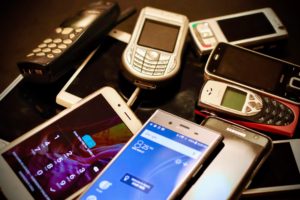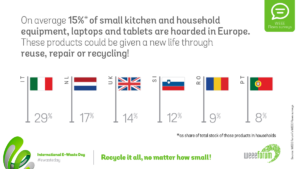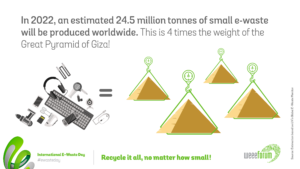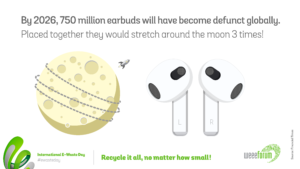 13/10/2022
13/10/2022Of ~16 Billion Mobile Phones Possessed Worldwide,
~5.3 Billion will Become Waste in 2022;
a Small Fraction will be Properly Disposed Of
Experts expect roughly 5.3 billion mobile / smartphones will drop out of use this year. Stacked flat atop one another at an average depth of 9 mm that many disused phones would rise roughly 50,000 km – 120 times higher than the International Space Station; one-eighth of the way to the moon.
And, despite their valuable gold, copper, silver, palladium and other recyclable components, experts expect a majority will disappear into drawers, closets, cupboards or garages, or be tossed into waste bins bound for landfills or incineration.
And, surprisingly, mobile phones rank 4th among small EEE products most often hoarded by consumers.
Hoarding of the many types of small, unused, dead or broken plug-in and battery-operated products is the focus of this year’s 5th annual International E-Waste Day.
Organizers today released the results of surveys conducted to reveal why so many households and businesses fail to bring Waste Electrical and Electronic Equipment (WEEE) in for repair or recycling.
The surveys were conducted from June to September, 2022 by the members of the WEEE Forum and the results were consolidated by the UN Institute for Training and Research (UNITAR) Sustainable Cycles (SCYCLE) Programme.
The surveys show that, of 8,775 European households in six countries representing the diversity of the European Union – Portugal, Netherlands, Italy, Romania and Slovenia, and separate UK survey, the average household contains 74 e-products such as phones, tablets, laptops, electric tools, hair dryers, toasters and other appliances (excluding lamps).
Of that 74 average total e-products, 13 are being hoarded (9 of them unused but working, 4 broken).
The top 5 hoarded small EEE products (by number of pieces*), Europe:
- Small consumer electronics and accessories (e.g. headphones, remote controls)
- Small household equipment (e.g. clocks, irons,)
- Small information technology equipment (e.g. external hard drives, routers, keyboards, mice)
- Mobile and smart-phones
- Small equipment for food preparation (e.g. toasters, food processing, grills)
(* By weight, discarded washing machines and other white appliances outweigh all other types of e-waste by far.)
Meanwhile, LED lamps rank tops the list of products most likely to be trashed.
Hoarded small kitchen and household equipment, laptops and tablets as share of total stock of those products in households:
- Italy (29%)
- Netherlands (17%)
- United Kingdom (14%)

- Slovenia (12%)
- Romania (9%)
- Portugal (8%)
- Lebanon (4%)
Top 5 reasons for hoarding WEEE of any kind, Europe:
- I might use it again in the future (46%)
- I plan on selling it / giving it away (15%)
- It has sentimental value (13%)
- It might have value in the future (9%)
- I don’t know how to dispose of it (7%)
Others
- Didn’t have time, forgot about it, does not take up too much space (3%)
- Planned use in secondary residence (3%)
- Presence of sensitive data (2%)
- There is no incentive to recycle (1%)
Says Pascal Leroy, Director General of the WEEE Forum, the organisation behind International E-Waste Day: “We focussed this year on small e-waste items because it is very easy for them to accumulate unused and unnoticed in households, or to be tossed into the ordinary garbage bin. People tend not to realise that all these seemingly insignificant items have a lot of value, and together at a global level represent massive volumes.”
“The producer responsibility organisations in the WEEE Forum that manage the collection of e-waste are constantly working to make the proper disposal of small e-waste simple and convenient for users and households,” says Mr. Leroy. “Providing collection boxes in supermarkets, pick up of small broken appliances upon delivery of new ones and offering PO Boxes to return small e-waste are just some of the initiatives introduced to encourage the return of these items.”
Adds Magdalena Charytanowicz of the WEEE Forum in charge of International E-Waste Day: “As noted in our short pu blic video (https://youtu.be/r8XIoquM40Y), in 2022 alone, small EEE items such as cell phones, electric toothbrushes, toasters and cameras produced worldwide will weight an estimated total of 24.5 million tonnes – four times the weight of the Great Pyramid of Giza. And these small items make up a significant proportion of the 8% of all e-waste thrown into trash bins and eventually landfilled or incinerated.”
blic video (https://youtu.be/r8XIoquM40Y), in 2022 alone, small EEE items such as cell phones, electric toothbrushes, toasters and cameras produced worldwide will weight an estimated total of 24.5 million tonnes – four times the weight of the Great Pyramid of Giza. And these small items make up a significant proportion of the 8% of all e-waste thrown into trash bins and eventually landfilled or incinerated.”
“These devices offer many important resources that can be used in the production of new electronic devices or other equipment, such as wind turbines, electric car batteries or solar panels – all crucial for the green, digital transition to low-carbon societies.”
In the past twenty years, the PROs in the WEEE Forum have collected, de-polluted, recycled or prepared for re-use more than 30 million tonnes of WEEE. They have spent enormous sums on communication campaigns. Still, challenges ahead remain daunting.
On 7 Dec. 2022 the Extended Producer Responsibility (EPR) Grand Challenge Conference (http://weeeforumconference.com) will mark the 20th anniversary of the WEEE Forum, a consortium of reputable e-waste collection organizations. The conference will also mark the 20th anniversary of EU Directive 2002/96/EC, the world’s first supranational (EPR) legislation on e-waste soon to be revised and updated.
Virginijus Sinkevičius, European Commissioner for the Environment, Oceans and Fisheries, commented: “The continuing growth in the production, consumption and disposal of electronic devices have huge environmental and climate impacts. The European Commission is addressing those with proposals and measures throughout the whole product life-cycle, starting from design until collection and proper treatment when electronics become waste.”
“Moreover, preventing waste and recovering important raw materials from e-waste is crucial to avoid putting more strain on the world’s resources. Only by establishing a circular economy for electronics, the EU will continue to lead in the efforts to urgently address the fast-growing problem of e-waste.”
Dr. Kees Baldé, Senior Scientific Specialist at UNITAR SCYCLE, and a lead researcher behind the Global e-Waste Monitor, noted that many small electronic products such as disposable airplane earbuds or cables and adapters accumulate largely unnoticed in many households. All the defunct earbuds accumulated by 2026 strung together would stretch around the moon three times.” 
“Moreover, over the past decade the growth in generated e-waste has been considerably higher than the growth in recycling, thus it is important to remind people of the importance of reusing or returning every single piece of electronics or electrical product that is forgotten about in household drawers.”
UN-led thought paper outlines options
Also launched to coincide with International e-Waste Day: a UN “thought paper” at https://www.itu.int/itu-d/sites/environment/ (available Oct. 14) offers a series of ideas and options for reducing the global problem.
Led by the UN’s International Telecommunication Union (ITU), with contributions from the WEEE Forum – which organizes International E-waste Day – and StEP, the Solving the eWaste Problem Initiative – the paper details the pros and cons of a wide range of options, including, for example:
- Making all entities that have access to e-waste subject to minimum legal obligations (All Actors principle)
- Deposit return and take-back schemes
- Digital product passports, and
- An international EPR regime of states agreeing on baseline standards for EEE treatment and depollution, and harmonized EEE definitions, categories, methodologies and principles.
UN certificate available to graduates of new 90-minute online e-waste training program
Meanwhile, UNITAR, the UN Institute for Training and Research (UNITAR), today also launched the first self-paced e-waste online training course open to anyone. A UNITAR certificate is available to graduates of the roughly 1.5 hour course (lectures, videos, illustrations, tests and a final exam).
The course will be available Oct. 14 at https://www.uncclearn.org
Says Nikhil Seth, UNITAR’s Executive Director and an instrumental figure in development of the Sustainable Development Goals, “UNITAR is proud of this new course on e-waste management as an outstanding example of how to use scientific findings in a practical way for international training and capacity building in an area of critical environmental importance.”
Adds Dr. Ruediger Kuehr, Founder of the SCYCLE Programme and Head of UNITAR’s Office in Bonn: “ International E-waste Day reminds us annually of the avalanche of problems we face unless we take appropriate measures, without which global e-waste could double to 100 million tonnes or more in the next 30 years. Consumption of electronics in many countries continues to grow, with more and more gadgets and products or embedded in such as furniture, clothes and toys, all of which eventually become e-waste.”
“We need to understand this growth and counter it with everyone involved: national authorities, enforcement agencies, Producer Responsibility Organisations, original equipment manufacturers, recyclers, researchers and consumers themselves.”
About
The WEEE Forum a.i.s.b.l. is an international association representing 51 producer responsibility organisations across the globe. Together with our members, we are at the forefront of turning the extended producer responsibility principle into an effective electronic waste management policy approach through our combined knowledge of the technical, business and operational aspects of collection, logistics, de-pollution, processing, preparing for reuse and reporting of e-waste. Our mission is to be the world’s foremost e-waste competence centre excelling in the implementation of the circularity principle.
Transparency Register ID 702397445-73.
Copyright 2019 All Rights Reserved
Contact
BluePoint conference and
business centre
Boulevard Auguste Reyerslaan 80
B-1030 Brussels
Belgium
Newsletter
Subscribe to our mailing list to get the updates to your email inbox.